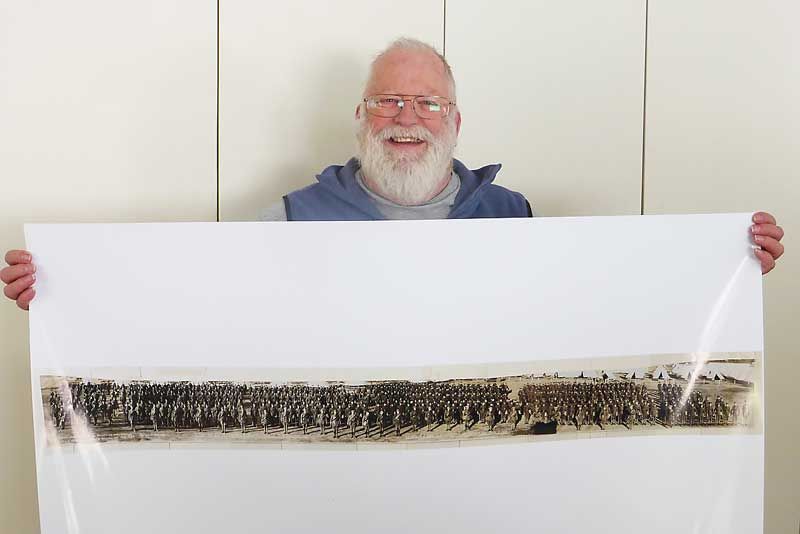Jan 12, 2015
Long-time Verona resident, Doug Lovegrove, recalled that when he first moved to Verona in 1980 he became interested in the history of WW1 and in particular, the 146th "Overseas” Battalion, a unit in the Canadian Expeditionary Forces based in Kingston, Ontario.
The unit was made up of soldiers and officers from the counties of Frontenac and Lennox and Addington and recruiting began in Kingston in late 1915. Recruiting offices were also set up in Tamworth, Enterprise, Flinton and Napanee and recruiting teams also visited many of the hamlets in both counties.
Lovegrove, who served as an electronics technician in the Canadian Army in both the RCEME and the RC SIGS from 1967 until he retired in 1992, said that he became intrigued with the 146th Battalion because “simply put, there was not very much information out there about it.”
Lovegrove began his research five years ago and the results of his efforts are now accessible online in a project he has titled "The 146th Research Project". It is comprised of two parts: the first, a history of WW1 and the 146th battalion and the second a more in-depth look at the estimated 600 to 800 soldiers and officers who were part of it.
While most of Doug's findings have come from information he has gleaned from the internet, a number of local residents have also helped shed light on its individual members after he put an advertisement in this newspaper asking readers for any information they might have.
When interviewed earlier this week Lovegrove said that information about the 146th Battalion in general is scarce due to the fact that the unit was not formed until November 28, 1915 and further, that as soon as the unit arrived in England, its members were absorbed into the many other existing units. “Of the 260 battalions that fought in WW1, only one third are well documented”, he said. “The 146th Battalion was absorbed almost immediately upon its arrival in England. When I started my research only two units, the 95th Battalion and the 12th Reserve were listed as the ones who absorbed members from the 146th, but so far I have found 27 other units where members of the 146th ended up.”
Much of the information about individual soldiers and officers Lovegrove gleaned by searching individual regimental numbers, which offer up information about a soldier's place of birth, the names of his parents, his marital status, sometimes medical information, as well as the unit they were assigned to when they arrived in England, the medals they received, if they were killed in action and where they were buried in Europe or at home. The website includes a listing of memorable dates that outline the battalion's formation in Kingston and its travels from Kingston to Valcartier, Quebec and on to Halifax, where its members boarded the HMT Southland. The ship was part of a large convoy that departed for Liverpool, England on September 27, 1916 and arrived on October, 6, 1916. To date Lovegrove has found 66 pictures of individuals who served in the 146th and has also located 93 gravestone markers, most of them in Europe and some in Canada.
One of Lovegrove's most cherished finds occurred just this past week when he came across the 146th Battalion's colours, which were presented by a Mrs. J. B. Pense on behalf of the citizens of Kingston and deposited immediately after the battalion's departure for England at St. Andrew's Church in Kingston. The colours can now be viewed online and "are a very important historical artifact and represent the insignia of the unit.”
Others important finds are a photo of the entire battalion that he came across online as well as a photo of local soldiers from the unit gathered at the train station in Sharbot Lake, circa 1915. The latter photo hangs in the office of Sharbot Lake resident Marcel Giroux.
For Lovegrove the project remains incomplete and he is still hoping to find out more information that any local residents might possess or know of. The project includes an information request sheet that can filled out for those who either would like information or have information to relate.
Lovegrove's work, it seems, is never ending. Eventually he hopes to create a data base with information about each individual member of the battalion. “There are so many stories that have yet to be told, ” he said.
In wrapping up our interview Lovegrove stressed the importance of the Canadian contribution to WW1. “From a total population of 8 million, 600,000 Canadians served in WW1, which is a huge number and it should be noted that Canada's contribution was recognized by the fact that they were asked to sign the Peace Treaty, which demonstrated the recognition of their incredible efforts and their huge sacrifices.”
To learn more about The 146th Research Project visit www.146battalion.ca and those with any information can email him at “This email address is being protected from spambots. You need JavaScript enabled to view it..” It should also be noted that Doug is the military historian for the Portland District and Area Heritage Society and he also welcomes any information and artifacts in that context as well.
More Stories
- Sticker Shock - EV Charging Station To Cost North Frontenac Township
- 30th Anniversary Verona Car Show
- The Forgotten Comfort Veg - Eggplant
- MERA Stage Comes Alive This Fall
- North Frontenac Council Report - August 27
- Addington Highlands Council Report - September 2
- Here's Grief - Have You Met
- Burn Ban Off in North Frontenac, Addington Highlands - Reduced to Level One in South and Central Frontenac
- The Resurgent Sharbot Lake County Inn and Crossing Pub
- Towards Then End of Trail

